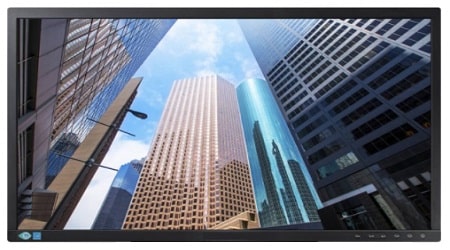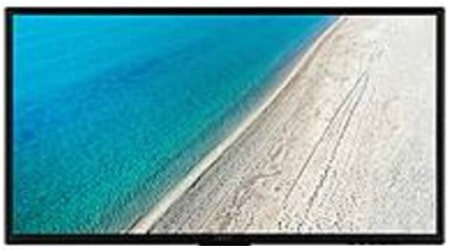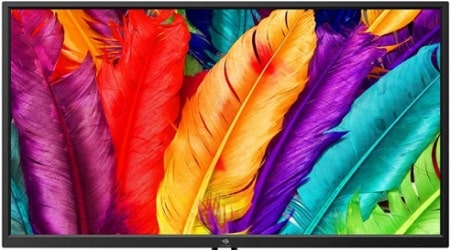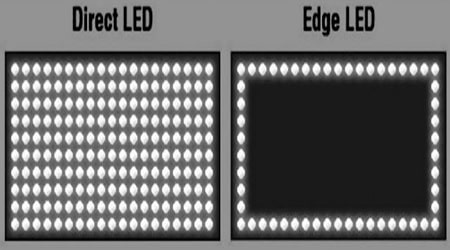What is the difference between Direct LED or Edge LED? Are one of these backlight technologies better than the other? Find out what the answer is in this guide.
If you are thinking about buying a new monitor, it might be helpful to know the difference between D-LED and E-LED. D-LED is better for colors, but E-LED uses less power.
It may seem that there is no difference, but it matters. One technology uses LED lights to light up your screen while the other one blends the colors.
Each light has a different result. It can make a difference in your experience, especially when it is dark.
In this article, we will look at the differences between LED and ELED. We will also discuss what Direct LED/Edge LED is. You can find out what is best for you.
In the end, you will know the most important thing to decide which TV or monitor to buy.
Table of Contents
What is LED/WLED?
LEDs are light-emitting diodes. They are small semiconductors that provide light to many different devices. LEDs are used for just about anything that needs light.
They use LEDs around the edges of the screen. You can see them because light guides show everything else.

WLEDs (White Light Emitting Diodes) or LEDs Light Emitting Diodes and are the same things. There is no difference between them.
The backlight in LCD screens of TVs and monitors is made up of lights. The lights give off light that interacts with the layer of liquid crystals on the screen to make an image.
LED monitors and TVs have lighting that is behind the liquid crystal layer. This makes the image better and brighter for a high dynamic range (HDR).
LED lights are a type of light that is different from other types. They can be used for many things. Direct LED is different from Edge-LED technology.
So, this technology has a low black level and high contrast for color transitions. This means that the picture quality is inversely proportional to the black level (picture quality will be good if there is a lot of darkness).
This can affect the image quality of your monitor. It is important to think about the type of LED you will go for, which will determine which one you get.
Here Details About: Best Monitor Calibrator.
What is Direct LED (D-LED)?
The panel with Direct LED lights is a type of FALD ( Full-Array Local Dimming ) panel. Both use an array of LED lights as their backlight. Old monitors were called Edge-Lit. They are still the most common type of monitor.

In Direct LED displays, there is no control of individual zones. This is different than FALD technology. FALD is backlight technology found on high-end monitors.
DLED panels are an option that is better than high-contrast or low-contrast light. It’s brighter too.
D-LED monitors and TVs are not as good because they are expensive, take more energy, and are thicker.
Direct LED backlight is a backlight that has LEDs behind the panel.
Here Details About: What is a Portable Monitor?
What is Edge LED (E-LED)?
Edge LED is a type of display. It has lights around the edge and not in the middle. These lights shine across the whole screen and make it bright, like a light bulb.
Other types of displays do not use backlight and are called DLED (Direct Light Emitting Diode).

It is the most common technology in monitors and TVs. Local dimming makes some parts of the screen brighter than others, so you can see better contrast.
FALD panels are even better because they make every part of the screen bright or dark at the same time.
An example of an edge-lit TV is the LG Nano cell TV. If you move the Magic controller in a dark scene, some of the edges will light up.
This is not because of light leakage, which happens when a bright area appears on a corner or edge of a TV screen.
LED lights are good for the environment. They also make TVs and monitors more energy efficient. There are some problems, however, like wall effect (clouding) and light leakage.
Most of the LCD monitors that we rate in our monitor Ratings now come with edge LED backlight. The LEDs are usually on the sides of the monitor.
Read here- OLED vs LCD vs Plasma.
Differences between Direct LED and Edge LED
Direct LED or Edge LED are both different. They have things in common, but they also have differences.
Direct LED is brighter and has better black uniformity, while Edge LED is cheaper, and you can add features to it.

More important than the kind of light on the screen is how it works. This will affect the quality of your image, brightness, contrast, and more.
There are 3 main kinds: IPS/VA/TN panels. Make sure to know these so you can pick which one you want!
- IPS – monitors and TVs have better color accuracy than other screens, but they can sometimes show a pinkish glow on the edges of the screen. They also can’t show blacks as well as other types of screens.
- TN – Used most often in monitors, Twisted Nematic technology focuses on performance and affordability. It is good because it has a low input lag and high refresh rate. But its colors are washed out and have poor contrast and viewing angles.
- VA – panels are used in TVs and monitors. The colors are good, but what is good about them is the contrast and black uniformity. They have problems with ghosting and motion blur due to the high response time.
Black Uniformity
Black uniformity measures how consistent the black color is on a screen. This is an advantage of Direct LED (D-LED) technology, which delivers more consistent colors but sacrifices color richness.
On Edge-Lit screens, you can get deep blacks. But it is not good for the screen to have a good uniformity across it. If you have a big screen, colors might be different depending on where you look.
Read Here About: Monitor Reviews.
Brightness Level
Direct LED screens are brighter because they use more backlights.
Edge LED screens are brighter than DLED lights. But because of how these lights are mapped, they can’t make the whole screen bright.
Energy consumption
The LCD-LED technology is very energy efficient. You will not feel a difference in your energy bill, no matter which one you pick.
However, Direct LED light panels to have so many more LEDs on them than Edge LED.
Size and design
Edge LED models are thinner and lighter than Direct LED ones. This makes them prettier and takes up less space on the desk. In contrast, DLEDs are thicker and a little heavier.
Price
When you buy a TV or monitor, the more expensive it is, the better quality. But even if the TV is not so expensive, it can still work well and be accurate.
When you buy a monitor, the price will depend on what type of monitor it is. An $800 IPS monitor won’t have as good build quality as a $2500+ IPS monitor.
Direct LED is used in many input displays. Edge LED is used in monitors of different prices. The interesting thing is to check to monitor ratings and decide what best suits your need and budget.
It is hard to say for sure what the price will be. It depends on the brand, screen size, and quality.
Which is better, Direct LED or Edge LED?
These two backlight technologies are not very different from the differences seen between different dashboard technologies.
So it is more about what design you like and how much energy efficiency you want.
Direct LED is better than other lights because it gives out more light, is less likely to have a light leak in the corners, and has better black uniformity.
Edge LED is better because it has a slim design and consumes less electricity. It also offers good contrast, but the disadvantage is that the black uniformity and light leakage are not good.
There are two types of LED monitors, Direct and Edge. They are very similar, but they have some differences.
You should choose one based on what you want. We recommend that you find a good balance between color fidelity and performance when choosing your monitor.
Last Words of Direct LED or Edge LED
We hope this guide has helped you understand the differences between Direct and Edge LED monitors.
The best monitor for your needs will depend on how you plan to use it, what features are important to you, and of course, what your budget is like.
We’ve listed some great monitors in our buying guide that we think would be a good fit based on various situations, so make sure to check them out! Thanks for reading!

